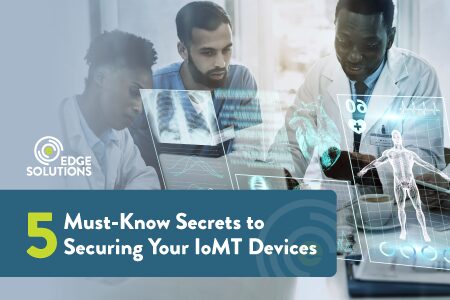
The Internet of Medical Things (IoMT) has transformed healthcare, connecting devices that enhance patient outcomes and streamline operations. From wearable monitors to connected imaging systems, IoMT has become essential in modern healthcare. But with this connectivity comes a significant risk—cyberattacks. The same features that make IoMT invaluable also make it a target for hackers. These attackers can exploit vulnerabilities to access sensitive patient data, disrupt care, or even control critical medical devices.
As IoMT devices become more widespread, it’s more important than ever to have strong security measures in place. We asked our in-house security experts about the essential strategies that every IT leader should focus on and here are their top 5 must-haves.
1. Network Segmentation
Segmenting your network is one of the most effective ways to secure IoMT devices. By isolating devices into smaller network segments, you reduce the risk of a breach spreading across your system. For example, placing IoMT devices on a separate network from core hospital systems ensures that even if one device is compromised, the attacker’s access is limited.
2. Strong Authentication and Access Controls
Many IoMT devices are vulnerable due to weak authentication mechanisms. Implementing strong, multi-factor authentication (MFA) and role-based access controls (RBAC) helps ensure that only authorized personnel can access these devices. Regularly reviewing and updating permissions is also crucial to minimizing insider threats.
3. Regular Updates and Patching
Keeping IoMT devices updated with the latest firmware and security patches is critical to defending against known vulnerabilities. However, many healthcare organizations struggle with this due to compatibility issues or the critical nature of the devices. Establishing a regular update process with automated alerts can help ensure that devices remain secure.
4. AI-Powered Monitoring Tools
Traditional security measures aren’t enough to detect threats on IoMT devices. AI-powered tools can analyze device behavior in real-time, identifying unusual patterns that could indicate a breach. For example, a device suddenly communicating with an unfamiliar IP address may be a red flag. Early detection allows for a swift response before threats escalate.
5. Zero Trust Security Model
A zero trust approach is particularly effective for securing high-risk IoMT devices. Under this model, no device or user is trusted by default—continuous verification is required before access is granted. Even if a device is compromised, its access to the broader network remains restricted, reducing the potential damage.
Securing IoMT devices is an ongoing challenge, but these strategies can significantly reduce your organization’s risk. At Edge Solutions, we partner with Palo Alto Networks to deliver advanced security solutions tailored to the healthcare industry. With Palo Alto’s zero trust approach, you can confidently secure IoMT devices while maintaining the highest standards of patient care and data protection.
For more insights on securing your healthcare environment, explore our detailed infographic.